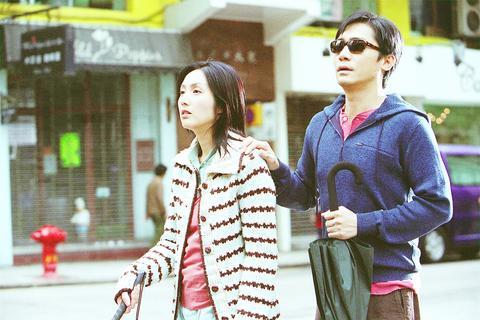As another adaptation of Taiwanese illustration book author Jimmy Liao's (
Unfortunately, the film has turned out to be a colorful and beautiful picture that looks like an extended version of a music video. It may be creative in creating characters and plot for the originally thinly-plotted illustration book and the performances are on the whole OK, but the result is less than the sum of its parts.
The original story of Sound of Colors is basically about a blind girl's lonely journey walking aimlessly through different MRT stations. The girl has a rich imagination and "sees" in her heart the colorful wonderland that is the world of the underground.

PHOTO COURTESY OF WARNER BROTHERS
The blind girl finds love, while a parallel romance takes place in a Shanghai subway station. Basically, fans of Liao's book should not expect a faithful adaptation. Rather, they should see it as a romance comedy with the Liao-style paintbox of bright colors, in which characters are clad with stylish, fluffy sweaters and scarves. The theme songs are in French, to add atmosphere.
Tony Leung (
In another plot line, Chang, an advertising company sales representative in Taipei sends a Christmas card to a girl whom he has a crush on. But the love letter is somehow switched and goes to Shanghai.

PHOTO COURTESY OF WARNER BROTHERS
His Shanghai client,, Dong Jie, a young business woman replies, revealing that she is also recovering from a failed lover affair. Chang then flies to Shanghai to find her. They meet in the subway, and, naturally enough, they fall for each other.
The romance of the Hong Kong couple, Leung and Yeung, looks more natural, because the details about how they cope with problems are more authentic. But the Shanghai romance is just plain cheesy.
Even more artificial is the character of Wing Fan (
He is the one who secretly matches up the two couples. Somehow his short appearances do not connect too well to the plot and rather than feeling this is a miracle, the overwhelming thought is: this is a bit bizarre.

Most heroes are remembered for the battles they fought. Taiwan’s Black Bat Squadron is remembered for flying into Chinese airspace 838 times between 1953 and 1967, and for the 148 men whose sacrifice bought the intelligence that kept Taiwan secure. Two-thirds of the squadron died carrying out missions most people wouldn’t learn about for another 40 years. The squadron lost 15 aircraft and 148 crew members over those 14 years, making it the deadliest unit in Taiwan’s military history by casualty rate. They flew at night, often at low altitudes, straight into some of the most heavily defended airspace in Asia.

Many people in Taiwan first learned about universal basic income (UBI) — the idea that the government should provide regular, no-strings-attached payments to each citizen — in 2019. While seeking the Democratic nomination for the 2020 US presidential election, Andrew Yang, a politician of Taiwanese descent, said that, if elected, he’d institute a UBI of US$1,000 per month to “get the economic boot off of people’s throats, allowing them to lift their heads up, breathe, and get excited for the future.” His campaign petered out, but the concept of UBI hasn’t gone away. Throughout the industrialized world, there are fears that

Taiwan’s democracy is at risk. Be very alarmed. This is not a drill. The current constitutional crisis progressed slowly, then suddenly. Political tensions, partisan hostility and emotions are all running high right when cool heads and calm negotiation are most needed. Oxford defines brinkmanship as: “The art or practice of pursuing a dangerous policy to the limits of safety before stopping, especially in politics.” It says the term comes from a quote from a 1956 Cold War interview with then-American Secretary of State John Foster Dulles, when he said: ‘The ability to get to the verge without getting into the war is

Like much in the world today, theater has experienced major disruptions over the six years since COVID-19. The pandemic, the war in Ukraine and social media have created a new normal of geopolitical and information uncertainty, and the performing arts are not immune to these effects. “Ten years ago people wanted to come to the theater to engage with important issues, but now the Internet allows them to engage with those issues powerfully and immediately,” said Faith Tan, programming director of the Esplanade in Singapore, speaking last week in Japan. “One reaction to unpredictability has been a renewed emphasis on